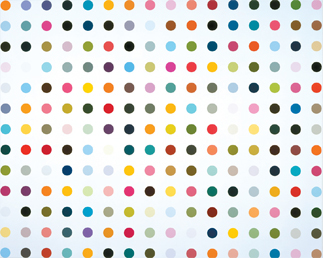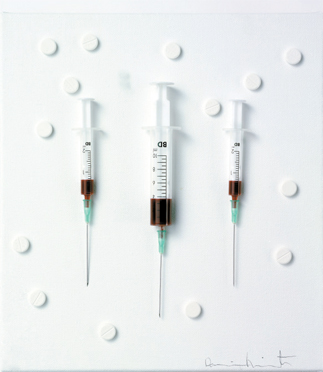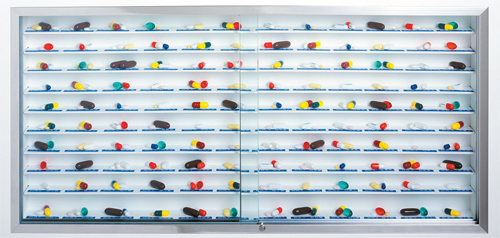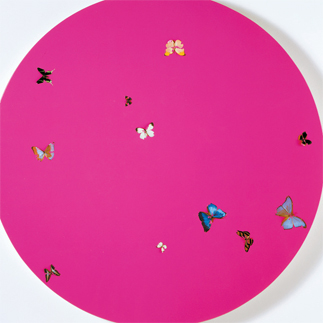Transformational art with butterflies and sharks

“Glycine-UL-C” by Damien Hirst. Household gloss on canvas. Provided by Leeahn Gallery
You can decide for yourself if you pop down to Daegu for an exhibition of the work of Damien Hirst, one of the most successful artists of our time.
Fifty Hirst pieces produced between 1990 and 2008 are on display in Leeahn Gallery under the title “Re-birth,” a concept that explores the theme of death.
The British artist earned notoriety for his series in which dead animals including a shark, sheep and cow were preserved in formaldehyde. In some cases, these animals were dissected into large pieces before they were immersed in the toxic chemical. “The Physical Impossibility of Death in the Mind of Someone Living,” a tiger shark submerged in formaldehyde in a glass-paneled cabinet, is one of his major works.

“Untitled Pill and Syringe 3,” which consists of three syringes, needles, resin and paracetamol pills on canvas.
One of his most recent works “For the Love of God, Believe” is a platinum cast of an 18th-century skull that has 8,601 diamond pieces weighing a total of 1,106.18 carats attached to it.
Though this work is not shown in the exhibition, a lesser-known piece is. It’s a skull with flies glued on to it called “The Fear of Death.”
For “Trinity II,” Hirst attached butterflies onto yellow, red and blue canvases.
Another butterfly painting, “Zinganja,” was made with butterflies stuck onto a pink, circular canvas.
Hirst used butterflies because their life cycle is determined by the larval caterpillar stage, an inactive pupal stage and a spectacular transformation into a colorful winged adult form.
“Butterflies symbolize a transition to different life stages,” said Kim Hae-kyung, the Leeahn Gallery curator in charge of the exhibition. “The two pieces revel in death but emphasize the beauty of these life phases.”

“Day by Day,” made of stainless steel, glass and wooden cabinet, plastic dymotape and pills.

“Zinganja,” household gloss on canvas.
“The pills are to reduce pain but no matter how much people take them, their life will eventually end,” Kim said.
The exhibition continues through April 25. The gallery is open from 10 a.m. to 6 p.m., except Mondays.

For more information, visit www.leeahngallery.com or call (053) 424-2203. Ticket price ranges from 5,000 won ($3.50) to 8,000 won.
By Limb Jae-un [jbiz91@joongang.co.kr]










with the Korea JoongAng Daily
To write comments, please log in to one of the accounts.
Standards Board Policy (0/250자)